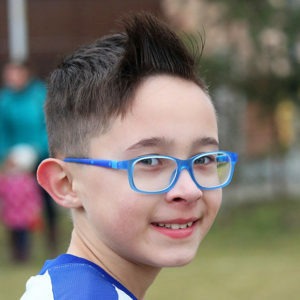In the blog post Is Your Child Struggling In School? It Could Be Vision Related Rather Than A Learning Problem, we took a look at how undiagnosed vision problems in children can all too often be misdiagnosed as learning disabilities or behavioral problems. 
In fact, 1 out of 4 children struggles with reading and learning because of undiagnosed vision problems, according to research by the College of Optometrists In Vision Development. It’s a serious, widespread problem.
However, kids don’t know that their vision isn’t “normal.” They may pass school vision exams without any red flags, but that’s because these typical childhood vision screenings miss at least 50% of vision problems that need to be evaluated for comprehensive vision.
Kids may be told that their eyesight is “fine,” and they have no other experience or reference to say otherwise. As a result, misdiagnosed vision problems can affect a child’s ability to learn and process information, not only in school but in everything they encounter.
But, on the flip side of undiagnosed vision problems, what happens when a child’s vision problems are correctly diagnosed and treated? What are the positive effects, not only on the way children learn but on how they navigate their world?
The short answer is that properly diagnosed vision issues in children can be life-changing. Here are 2 examples of how the right vision test—and correctly prescribed eyeglasses—changed a child’s life:
“Whoa Moments” Of Seeing Clearly
Lexi (*not her real name) was in 7th grade and had no idea she was having, or ever had, for that matter, vision problems. Her vision didn’t register any red flags during school screenings or eye-chart tests with her pediatrician, and her parents were never advised to have her vision checked further with an eye doctor.
However, her mother began to notice that Lexi was having more frequent headaches, and wondered if her eyesight could be to blame. After all, Lexi’s mother had needed to start wearing glasses when she was in middle school, so perhaps there was a family history component that needed to be checked out.
Sure enough, a comprehensive exam revealed exactly the seemingly subtle ways that Lexi’s vision was compromised, and how properly prescribed eyeglasses could easily improve her eyesight.
Lexi’s mom recalls that in the weeks that followed after Lexi began wearing her glasses, Lexi kept commenting on how crisp and clear things were. She pointed out details in the world around her that she just didn’t even know she had been missing.
“She didn’t know things didn’t look “normal” until we found out she needed glasses,” Lexi’s mother said, adding, “Then she had so many comments that what we started to call “whoa moments” after getting her glasses. She was literally seeing things in a new way.”
Big Improvements In Learning At School
In addition to more clearly seeing things around her, Lexi’s headaches also greatly improved once her vision was properly examined and she began wearing prescribed eyeglasses. However, many kids also experience rewards aside from fewer headaches, as was the case with Eric (*not his real name).
Like Lexi, Eric also didn’t even realize he wasn’t seeing things clearly, but it turned out that his impaired vision was having a serious impact on his ability to learn in school, as well as at home.
Eric was in 2nd grade, and since kindergarten, he had been behind the other kids his age in reading comprehension and overall speed of learning. His parents kept thinking that Eric would catch up, but as 2nd grade neared an end, they sat down with his teachers to discuss the possibility that he might have a learning disability.
Luckily, one of his teachers had experienced other students who had vision problems that, until diagnosed, affected how well they were able to learn. She recommended that Eric’s parents visit an optometrist to give him a comprehensive vision exam.
Her advice was spot on, especially since school “20/20” vision screenings only test that a child can see at a distance of 20 feet. These typical screenings miss at least 50% of vision problems in children.
Sure enough, the optometrist’s comprehensive exam revealed that Eric had trouble coordinating the focus in both eyes. Not being able to coordinate focus between both eyes typically causes problems like skipping or rereading lines, lagging in reading comprehension, taking longer to do homework, or having a shorter attention span.
Once Eric’s eyesight was corrected with properly prescribed eyeglasses, he immediately started doing better in school with both reading speed and comprehension. His ability to learn overall also improved, not to mention his parents noticed that his frustration with school work decreased significantly.
How To Catch Unknown Vision Problems In Kids
As we’ve discussed, children don’t know that they aren’t seeing correctly, unless it’s very obvious that objects appear blurry. In those cases vision eye-chart tests at school often pick up the problems, but there are many vision issues that are not detected by these routine tests.
Parents also may not be aware that vision could be a problem in how a child interprets things around them, either. This is understandable, especially when there haven’t been any obvious signs or red flags that a child’s eyesight is anything less than normal.
For these reasons, all children should have comprehensive eye exams throughout their childhood and teenage years. The earlier a vision problem is detected and treated, the more likely treatment will be successful. When needed, an optometrist can prescribe glasses, contact lenses, or vision therapy to correct childhood vision problems.
At Hardin Valley Eyecare & Optical in Knoxville, we are dedicated to helping children have the best vision possible so that they don’t have to struggle with daily tasks. Our eye care professionals are dedicated to providing exceptional personal service to each person—including our very youngest patients—who walks through our door. If you want to schedule an eye exam for your child, call us at (865) 409-1253 or contact us to schedule an appointment.





